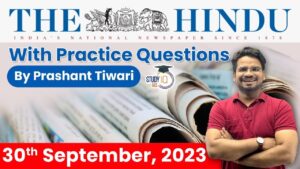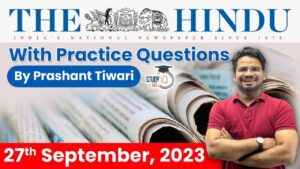The Hindu Newspaper Analysis for UPSC

The Hindu Newspaper Analysis 23 May 2023
- If citizens want to exercise the right to fill the Census form on their own rather than through government enumerators, they will have to first update their National Population Register (NPR) details online.
- The NPR, first put together in 2010 and updated in 2015, already has the details of 119 crore people.
- Census 2021, which has been postponed indefinitely, will be the first digital Census giving citizens an opportunity to “self-enumerate” as and when it is conducted.
- The government has not announced when the next census will be held, with a January 2 notification ruling out the exercise at least till September.
The Hindu Editorial Today
- About:
- NPR is a database containing a list of all usual residents of the country.
- A usual resident for the purposes of NPR is a person who has resided in a place for six months or more and intends to reside there for another six months or more.
- Its objective is to have a comprehensive identity database of people residing in the country.
- It is generated through house-to-house enumeration during the “house-listing” phase of the Census.
- The NPR was first collected in 2010 and then updated in 2015.
- Legal Backing:
- The NPR is prepared under the provisions of the Citizenship Act 1955 and the Citizenship (Registration of Citizens and Issue of National Identity Cards) Rules, 2003.
- It is mandatory for every “usual resident of India” to register in the NPR.
- What is the Difference between NPR and Census?
- The census involves a detailed questionnaire – there were 29 items to be filled up in the 2011 census – aimed at eliciting the particulars of every person, including age, sex, marital status, children, occupation, birthplace, mother tongue, religion, disability and whether they belonged to any Scheduled Caste or Scheduled Tribe.
- On the other hand, the NPR collects basic demographic data and biometric particulars.
Legal Basis:
- The census is legally backed by the Census Act, 1948.
- The NPR is a mechanism outlined in a set of rules framed under the Citizenship Act, 1955.
- The first complete census of an Indian city was conducted in 1830 by Henry Walter (known as the father of the Indian Census) in Dacca.
- First non-synchronous Census was conducted in India in 1872 during the reign of Governor-General Lord Mayo.
- The first synchronous census was taken in 1881, by W.C. Plowden, Census Commissioner of India. Since then, censuses have been undertaken uninterruptedly once every ten years.
- Nodal Ministry:
- The decennial Census is conducted by the Office of the Registrar General and Census Commissioner, Ministry of Home Affairs.
- The population census is a Union subject under Article 246 of India Constitution.

- The Census has a lot of potential in policymaking and the exercise is not merely about counting the population.
- Unfortunately, the limited information collected, and the under-utilisation or non-utilisation of Census data, have narrowed the role of the Census in policymaking
- the Census offers two units of analysis: at the individual level and at the household level.

- Encroachments on Drainage Channels: In Indian cities and towns, due to increased land prices and less availability of land in the city centre. New developments are coming up in low-lying areas, usually as encroachments over lakes, wetlands and riverbeds.
- Encroachment: A large number of wetlands that soaked up the rainwater has encroached. Bangalore had 262 lakes in the 1960s; now only 10 of them hold water.
- Rapid and unplanned urbanization: In Bengaluru, stormwater drains were not directly connected to its water bodies. In some places, the runoff water was flowing into constructed deviation canals. CAG found that this increased the chances of flash floods.
- Destruction of mangroves: Mumbai lost about 40% of its mangroves between 1995 and 2005.
- Poor civic management of storm water drainage: CAG report (last year) pulled up Bengaluru municipality for this poor management.

- The sport of jallikattu involves men competing against each other by holding on to the humps of agitated bulls that are released into an open arena. The Supreme Court, in 2014, had previously declared the practice illegal.
- There, in A. Nagaraja, a two-judge Bench held that bulls could never be performing animals, that they were anatomically ill-suited for competition, and were effectively being forced into participating in a practice that caused them unnecessary pain and suffering. Therefore, in the Court’s belief, any conduct of jallikattu breached the Prevention of Cruelty to Animals Act, 1960.
- To overcome the judgment, the Government of Tamil Nadu, in 2017, introduced a series of amendments to the 1960 Union law. Through these changes, the State ensured that jallikattu was altogether exempted from the protections that the statute offered.

- The case of BRICS is truly remarkable. Despite several achievements, it began to lose its sparkle. COVID-19, the Galwan clash, and the Ukraine conflict resulted in increased global economic stress, damaged India-China ties, and turned Russia into a diminishing power.
- Jim O’Neil’s conception of BRIC, a grouping of four emerging economies (Brazil, Russia, India, and China), may not have gone far but it was a popular acronym over two decades ago. However, two of its components joined hands with South Africa to form IBSA (India, Brazil, South Africa) in 2003.
- IBSA has been unable to hold its summit since 2011. But BRICS has held 14 summits in the past 13 years.
- BRICS focused its attention on both geopolitical and economic dimensions. By articulating a common view on key global and regional issues, it projected a non-western view.
- On the economic front, it launched new initiatives: the New Development Bank which has committed $32.8 billion in 96 projects; the Contingent Reserve Arrangement (CRA), a financial mechanism to protect against global liquidity pressures; and a comprehensive programme to expand trade and investment cooperation among the five-member countries.
- 19 countries now stand in line, eager to join BRICS. The regional breakup is as follows: Latin America (four) – Argentina, Nicaragua, Mexico and Uruguay; Africa (five) – Nigeria, Algeria, Egypt, Senegal and Morocco; and Asia (10) – Saudi Arabia, the United Arab Emirates (UAE), Türkiye, Syria, Iran, Afghanistan, Indonesia, Thailand, Kazakhstan and Bangladesh.
- The next BRICS summit will be hosted by South Africa on August 23-24.
- About:
- BRICS is an acronym for the grouping of the world’s leading emerging economies, namely Brazil, Russia, India, China, and South Africa.
- In 2001, the British Economist Jim O’Neill coined the term BRIC to describe the four emerging economies of Brazil, Russia, India, and China.
- The grouping was formalised during the first meeting of BRIC Foreign Ministers’ in 2006.
- South Africa was invited to join BRIC in December 2010, after which the group adopted the acronym BRICS.
- The chairmanship of the forum is rotated annually among the members, in accordance with the acronym B-R-I-C-S.
- India is the chair for 2021.

- One more cheetah, this time a cub, died at the Kuno National Park (KNP) in Madhya Pradesh, wildlife authorities said on Tuesday.
- The two-month-old cub was one of four born to Jwala, who was among the set of eight cheetahs imported from Namibia.
- The likely cause of death, officials said, was “from weakness”, with a press note from the Centre stating that the two-month-old cub was the “smallest and weakest of the litter”.
- Literature and experience from Africa suggests that cheetah cubs, in the wild, have a survival rate of 10%, and roughly the same fraction make it to adulthood, the government’s press release noted.
- This is the fourth cheetah to have died in India since 20 of the animals were relocated from Namibia and South Africa respectively to the KNP.
- Earlier this month, an adult female, Daksha, died following injuries involving a skirmish among the animals. Two other animals, Sasha and Uday, died in February and April, respectively, from a renal infection and cardiovascular problems, respectively. Daksha’s death had brought the total number of adult cheetahs to 17.
- “The typical mortality [in a litter] of tiger cubs is around 50% and wild cheetahs is 90%. So, it wouldn’t be surprising to see more deaths,” S.P. Yadav, Director, National Tiger Conservation Authority (NTCA), the organisation tasked with coordinating Project Cheetah, told The Hindu.

- In 1969, KWDT was set up under the Inter-State River Water Dispute Act, 1956,
- It was headed by Justice R.S. Bachawat,
- It was constituted in April 1969 for adjudication of inter-state water dispute regarding the sharing of Krishna waters.
- It presented its report in 1973 which was published in 1976.
- It divided the 2060 TMC (thousand million cubic feet) of Krishna water at 75 per cent dependability into three parts: 560 TMC for Maharashtra, 700 TMC for Karnataka and 811 TMC for Andhra Pradesh.
- The A.P. government later apportioned it in the 512:299 tmcft ratio between Andhra and Telangana.
- There is no mention of water shares in the Andhra Pradesh Reorganisation Act, 2014, since the KWDT-I Award, which was still in force, had not made any region-wise allocation.
- At a meeting convened by the then Ministry of Water Resources in 2015, the two States had agreed for sharing water in the 34:66 (Telangana:A.P.) ratio as an ad hoc arrangement with the minutes clearly specifying that it has to be reviewed every year.
- Telangana has been arguing that as per the basin parameters, it is entitled for at least a 70% share in the allocation of the 811 tmcft.
Krishna River
- The Krishna is an east-flowing river.
- Originates at Mahabaleshwar in Maharashtra and merges with the Bay of Bengal
- Flows through Maharashtra, Karnataka, Telangana and Andhra Pradesh.
- Together with its tributaries, it forms a vast basin that covers 33% of the total area of the four states.
- The principal tributaries joining Krishna are the Ghataprabha, the Malaprabha, the Bhima, the Tungabhadra and the Musi.
- Most of this basin comprises rolling and undulating country, except for the western border, which is formed by an unbroken line of the Western Ghats.
- The important soil types found in the basin are black soils, red soils, laterite and lateritic soils, alluvium, mixed soils, red and black soils and saline and alkaline soils.


 The Hindu Newspaper Analysis 6 October 2...
The Hindu Newspaper Analysis 6 October 2...
 The Hindu Newspaper Analysis 30 Septembe...
The Hindu Newspaper Analysis 30 Septembe...
 The Hindu Newspaper Analysis 27 Septembe...
The Hindu Newspaper Analysis 27 Septembe...





















